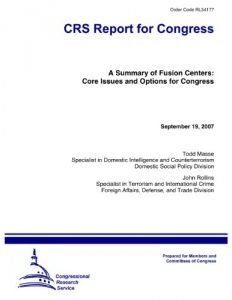This report summarizes the main points of CRS Report RL34070, Fusion Centers: Issues and Options for Congress, by Todd Masse, Siobhan O’Neil, and John Rollins. It highlights the value proposition of such centers, as well as the obstacles and risks they face. All of the information provided herein is provided in greater detail in the original report, which will be updated as necessary.
Although elements of the information and intelligence fusion function were conducted prior to 9/11, often at state police criminal intelligence bureaus, the events of 9/11 provided the primary catalyst for the formal establishment of more than 40 state, local, and regional fusion centers across the country. The value proposition for fusion centers is that by integrating various streams of information and intelligence, including that flowing from the federal government, state, local, and tribal governments, as well as the private sector, a more accurate picture of risks to people, economic infrastructure, and communities can be developed and translated into protective action. The ultimate goal of fusion is to prevent man-made (terrorist) attacks and to respond to natural disasters and man-made threats quickly and efficiently should they occur. Fusion centers are state-created entities largely financed and staffed by the states, and there is no one “model” for how a center should be structured. State and local law enforcement and criminal intelligence seem to be at the core of many of the centers. While many of the centers have prevention of attacks as a high priority, little “true fusion” — analysis of disparate data sources, identification of intelligence gaps, and pro-active collection of intelligence against those gaps which could contribute to prevention — is occurring.
Although elements of the information and intelligence fusion function were conducted prior to 9/11, often at state police criminal intelligence bureaus, the events of 9/11 provided the primary catalyst for the formal establishment of more than 40 state, local, and regional fusion centers across the country. The value proposition for fusion centers is that by integrating various streams of information and intelligence, including that flowing from the federal government, state, local, and tribal governments, as well as the private sector, a more accurate picture of risks to people, economic infrastructure, and communities can be developed and translated into protective action. The ultimate goal of fusion is to prevent man-made (terrorist) attacks and to respond to natural disasters and man-made threats quickly and efficiently should they occur. Fusion centers are state-created entities largely financed and staffed by the states, and there is no one “model” for how a center should be structured. State and local law enforcement and criminal intelligence seem to be at the core of many of the centers. While many of the centers have prevention of attacks as a high priority, little “true fusion” — analysis of disparate data sources, identification of intelligence gaps, and pro-active collection of intelligence against those gaps which could contribute to prevention — is occurring.






